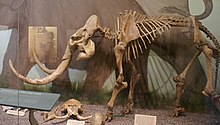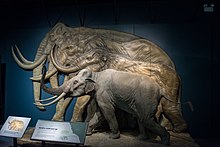| Pygmy mammoth Temporal range: Late Pleistocene
| |
|---|---|

| |
| Skeleton at the Santa Barbara Museum of Natural History | |

| |
| Model of a pygmy mammoth (front) at the Cleveland Museum of Natural History | |
| Scientific classification | |
| Domain: | Eukaryota |
| Kingdom: | Animalia |
| Phylum: | Chordata |
| Class: | Mammalia |
| Order: | Proboscidea |
| Family: | Elephantidae |
| Genus: | †Mammuthus |
| Species: | †M. exilis
|
| Binomial name | |
| †Mammuthus exilis (Stock & Furlong, 1928)[1]
| |
The pygmy mammoth or Channel Islands mammoth (Mammuthus exilis) is an extinct species of dwarf mammoth native to the northern Channel Islands off the coast of southern California during the Late Pleistocene. It was descended from the Columbian mammoth (M. columbi) of mainland North America, which are suggested to have colonised the islands around 250–150,000 years ago. At only 1.72–2.02 m (5.6–6.6 ft) tall at the shoulder, it was around 17% the size of its mainland ancestor. The species became extinct around 13,000 years ago, co-inciding with major environmental change and the arrival of humans in the Channel islands.
- ^ Chester Stock and E. L. Furlong (1928). "The Pleistocene elephants of Santa Rosa Island, California" (PDF). Science. 68 (1754): 140–141. Bibcode:1928Sci....68..140S. doi:10.1126/science.68.1754.140. PMID 17772244.